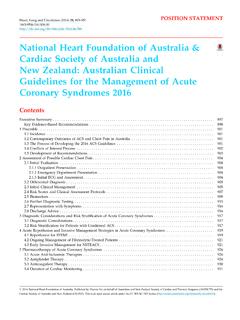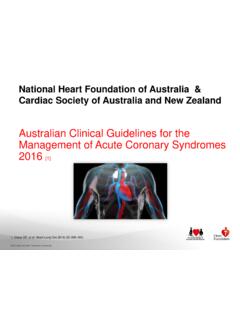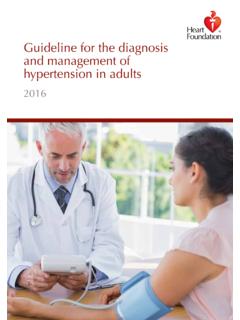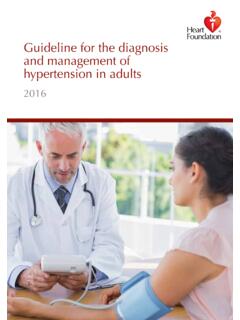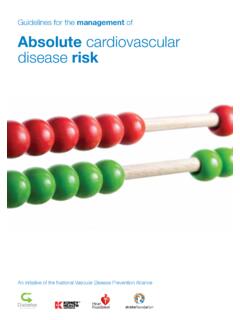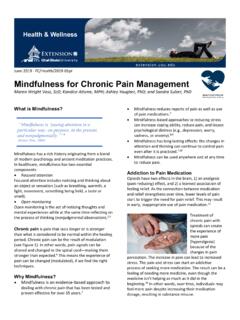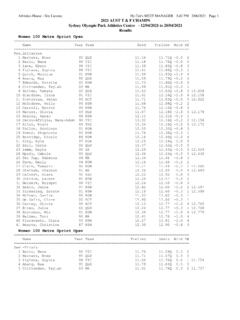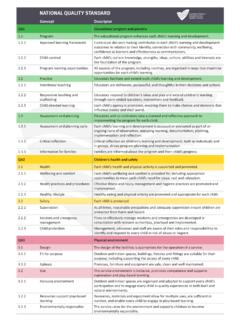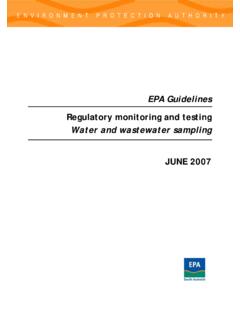Transcription of Australian Clinical Guidelines for the Management of …
1 National Heart Foundation of Australia &. Cardiac Society of Australia and New Zealand Australian Clinical Guidelines for the Management of acute coronary Syndromes 2016 [1]. 1. Chew DP, et al. Heart Lung Circ 2016; 25: 895 951. 2016 National Heart Foundation of Australia Prevalence Chest pain and acute coronary syndrome (ACS) symptoms are common presenting complaints in emergency departments (EDs). There were 68,200 ACS events recorded in 2012 [1]. >500,000 patients present with chest pain in Australia each year, but 80% of all patients investigated for ACS do not have a diagnosis confirmed [1,2]. There are significant health burdens and health sector costs associated with ACS. diagnosis and assessment. 1. Australian Institute of Health and Welfare. 2014. Cardiovascular disease, diabetes and chronic kidney disease Australian facts: Prevalence and incidence. 2. Cullen L, et al. Med J Aust 2015;202 (8):427 32.
2 2016 National Heart Foundation of Australia Background Aim is to provide a Clinical guideline to assist the Management of patients presenting with chest pain, due to suspected or confirmed ACS. Intended to replace the NHFA/CSANZ ACS Guidelines of 2006 [1] , addenda 2007 [2] and 2011 [3]. These Guidelines should be read in conjunction with: ACS Clinical Care Standards developed by the Australian Commission for Safety and Quality in Health Care (ACSQHC) [4]. Australian acute coronary Syndromes Capability Framework developed by the Heart Foundation [5]. 1. ACS Guidelines Working Group. Med J Aust. 2006;184(8):S1-30. 2. Aroney CN, et al. Med J Aust. 2008;188(5):302- 3. 3. Chew DP, et al. Heart Lung Circ. 2011;20(8):487-502. 4. ACSQHC. ACS Clinical Care Standard. 2014. 5. NHFA. Australian ACS capability framework. 2015. 2016 National Heart Foundation of Australia Working Group An ACS Guideline Development Working Group was facilitated by the National Heart Foundation of Australia (NHFA) in partnership with Cardiac Society of Australia and New Zealand (CSANZ).
3 The Working Group included a broad mix of health professionals, including a general practitioner, general physician, cardiac surgeon, pathologist, ambulance representative, cardiologists, emergency physicians, exercise physiologists, cardiac nurses and a consumer representative. 2016 National Heart Foundation of Australia The process for developing the Guidelines Literature review: informed by stakeholder consultation, the working group developed Clinical questions on which the literature review was based conducted by an external literature reviewer, who was appointed though an open tender process (KP Health). included published studies from 2010 to 2015. 2016 National Heart Foundation of Australia The process for developing the Guidelines Governance Processes in place to ensure transparency, minimise bias, manage conflict of interest (COI) and limit other influences during development.
4 Recommendations developed using NHMRC (level of evidence). GRADE methodology (strong or weak). 2016 National Heart Foundation of Australia The process for developing the Guidelines Public consultation period of 30 days in April 2016 on the final draft. NHFA and CSANZ Clinical committee and National Board approvals followed. Endorsed by key stakeholder organisations. Publication in peer review journals August 2016. 2016 National Heart Foundation of Australia What is new from previous Guidelines ? Recommendations are graded on the strength of the evidence and the expected value of the intervention. Recommendations focus on the interventions and therapies most likely associated with improved outcomes. Use of practice points to highlight aspects of care that are supported by limited evidence or modest benefits. Focus on pathways for the assessment of patients with suspected ACS. 2016 National Heart Foundation of Australia What is new from previous Guidelines ?
5 Guidance on: troponin testing integrated into chest pain assessment pathways patient groups not requiring further testing duration of cardiac monitoring prompt transfer of patients receiving fibrinolysis in STEMI. provision and timing of early invasive Management in NSTEACS. reduced indication for glycoprotein IIb/IIIa inhibition combination antiplatelet and anti-thrombin therapy duration of P2Y12 inhibition reduced indication for beta-blocker therapy. 2016 National Heart Foundation of Australia Recommendations 2016 National Heart Foundation of Australia Initial assessment of chest pain Recommendation Grade 1. It is recommended that a patient with acute chest pain or other symptoms Strong suggestive of an ACS receives a 12-lead ECG and this ECG is assessed for IIIC. signs of myocardial ischaemia by an ECG-experienced clinician within 10. minutes of first acute Clinical contact. 2.
6 A patient presenting with acute chest pain or other symptoms suggestive of ACS Strong IA. should receive care guided by an evidence-based Suspected ACS Assessment Protocol (Suspected ACS-AP) that includes formal risk stratification. 3. Using serial sampling, cardiac-specific troponin levels should be measured at Strong IA. hospital presentation and at clearly defined periods after presentation using a validated Suspected ACS-AP in patients with symptoms of possible ACS. 2016 National Heart Foundation of Australia Practice points Oxygen supplementation Routine use of oxygen therapy among patients with a blood oxygen saturation (SaO2) level > 93% is not recommended, but its use when the SaO2 is below this level is advocated, despite the absence of Clinical data [1,2]. Target SaO2 level for patients with chronic obstructive pulmonary disease is 88 92%. Initial aspirin therapy In all patients with possible ACS and without contraindications, aspirin (300 mg orally) should be given as soon as possible after presentation.
7 Additional antiplatelet and anticoagulation therapy, or other therapies such as beta blockers, should not be given to patients without a confirmed or probable diagnosis of ACS. JB, Burls A, Emparanza JI, et al. Oxygen therapy for acute myocardial infarction. Cochrane Database Syst Rev 2013; (8): CD007160. 2. Stub D, Smith K, Bernard S, et al. Air versus oxygen in ST-segment-elevation myocardial infarction. Circulation 2015;. 131: 2143-2150. 2016 National Heart Foundation of Australia Initial assessment of chest pain Recommendation Grade 4. Non-invasive objective testing is recommended in intermediate-risk patients, as Weak defined by a validated Suspected ACS-AP, with normal serial troponin and ECG IA. testing and who remain symptom-free. 5. Patients in whom no further objective testing for coronary artery disease (CAD) Weak is recommended are those at low risk, as defined by a validated Suspected III-3C.
8 ACS-AP: age <40 years, symptoms atypical for angina, in the absence of known CAD, with normal troponin and ECG testing, and who remain symptom- free. 6. The routine use of validated risk stratification tools for ischaemic and bleeding Weak events ( GRACE score for ischaemic risk or CRUSADE score for bleeding IIIB. risk) may assist in patient-centric Clinical decision-making in regards to ACS. care. 2016 National Heart Foundation of Australia Assessment protocols for suspected ACS. Point of care assays Sensitive lab-based assays Highly sensitive lab-based assays 2016 National Heart Foundation of Australia Differential diagnosis of causes of chest pain Ischaemic cardiovascular ACS ( acute myocardial infarction, unstable angina). causes Stable angina Severe aortic stenosis Tachyarrhythmia (atrial or ventricular). Non-ischaemic Aortic dissection (tear between the layers of the wall of the aorta) and cardiovascular expanding aortic aneurysm causes of chest pain Pulmonary embolism Pericarditis and myocarditis Gastrointestinal causes ( gastro-oesophageal reflux, oesophageal spasm, peptic ulcer, pancreatitis, biliary disease).
9 Non-cardiovascular Musculoskeletal causes ( costochondritis, cervical radiculopathy, causes fibrositis). Pulmonary ( pneumonia, pleuritis, pneumothorax). Other aetiologies ( sickle cell crisis, herpes zoster). 2016 National Heart Foundation of Australia Causes of troponin elevation*. Cardiac contusion, or other trauma including surgery, ablation, pacing, frequent defibrillator shocks Congestive heart failure acute and chronic coronary vasculitis, SLE, Kawasaki syndrome Aortic dissection Aortic valve disease Hypertrophic cardiomyopathy Tachy- or bradyarrhythmias, or heart block Stress cardiomyopathy (Takotsubo cardiomyopathy). Rhabdomyolysis with cardiac injury Pulmonary embolism, severe pulmonary hypertension Renal failure acute neurological disease, including stroke or subarachnoid haemorrhage Infiltrative diseases, amyloidosis, haemochromatosis, sarcoidosis, and scleroderma Inflammatory diseases, myocarditis or myocardial extension of endo-/pericarditis Drug toxicity or toxins anthracyclines, CO poisoning Critically ill patients, especially with respiratory failure or sepsis Hypoxia Burns, especially if affecting > 30% of body surface area Extreme exertion False positives: Cross reacting heterophile antibodies *Life threatening, non- coronary conditions highlighted in bold 2016 National Heart Foundation of Australia Markers of increased risk with confirmed ACS.
10 Risk classification Clinical characteristic Very high Haemodynamic instability, heart failure, cardiogenic shock or mechanical complications of MI. Life-threatening arrhythmias or cardiac arrest Recurrent or ongoing ischaemia chest pain refractory to medical treatment, or recurrent dynamic ST-segment and/or T-wave changes, particularly with intermittent ST-segment elevation, de Winter T-wave changes, or Wellens'. syndrome , or widespread ST-segment elevation in two coronary territories High Rise and/or fall in troponin level consistent with MI. Dynamic ST-segment and/or T-wave changes with or without symptoms GRACE Score >140. Intermediate Diabetes mellitus Renal insufficiency (GFR<60mL/ ). LVEF <40%. Prior revascularisation: PCI or CABG. GRACE score >109 and <140. GRACE, Global Registry of acute coronary Events; GFR, glomerular filtration rate; LVEF, left ventricular ejection fraction; PCI, percutaneous coronary intervention; CABG, coronary artery bypass grafting; MI, myocardial infarction 2016 National Heart Foundation of Australia acute reperfusion and invasive Management Recommendation Grade 1.
